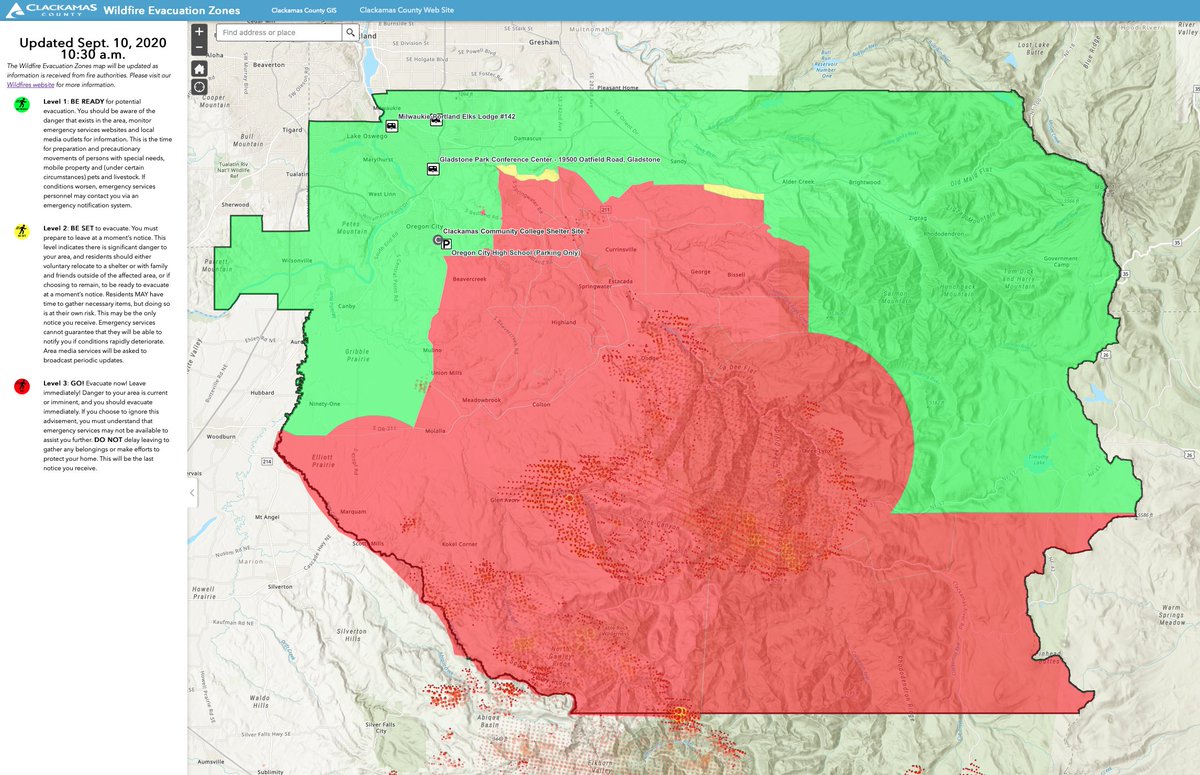
“Many kinds of emergencies can cause you to have to evacuate. In some cases, you may have a day or two to prepare while other situations might call for an immediate evacuation. Planning is vital to making sure that you can evacuate quickly and safely no matter what the circumstances.” — https://www.ready.gov/evacuation
With numerous wildfires encroaching on communities throughout Oregon, this is time for families to think in terms of safety. If your family is in or near an evacuation zone, clear information on what these zones mean can be found at http://www.bces.wa.gov/home/bcem-1/evacuation-levels:
Level 1: READY – Level 1 evacuations are an Alert. Residents should be aware of a danger that exists. Now is the time to “Get Ready.” Residents with special needs, or those with pets or livestock, should take note and prepare for relocating family members, pets and livestock. Refine your evacuation plans and gather the things you will need if you must evacuate.
Level 2: SET – Level 2 evacuations indicate there is a significant risk to your area. Now is the time to be set for immediate evacuation. Residents should either voluntarily relocate to a shelter or designated area or with family/friends outside the area or be ready to leave at a moment’s notice.
Level 3: GO! – Level 3 means there is immediate danger. GO NOW! You are advised to evacuate immediately.
Getting Ready (Level One):
There is plenty of good information on the web for emergency preparedness. Remember to reduce the risk of injury, stay calm; plan ahead and have practice drills with your children. Sketch a floor plan and mark where the utility switches or gas values are on your plan. Show a second way to exit from each room or area. Teach your children how to administer first aid, how to turn off water, gas and electricity in your home. When conducting drills, ask your children questions to make sure they remember the plan and how to contact you if you are not together when the level three Go Now order comes through. If your family owns a fire extinguisher, remember these are only intended to clear a path to your exit. Let the fire department fight the fire; don’t use an extinguisher to try to save your home. And If you need to clear a path to exit your home, always aim the extinguisher at the base of the flame.
Write down important information:
1. Radio and television broadcast stations to tune to for emergency broadcast information.
2. Important telephone numbers, such as emergency departments, paramedics and medical centers.
3. Names, addresses and telephone numbers of your insurance agents.
4. Telephone numbers of utilities.
5. Landlord or property managers; and neighbors &/or family.
6. Allergy, medications and brief medical history if needed.
If your family has special needs, such as physical and mental disabilities:
- Build your home safety plan around your abilities.
- Smoke alarms with a vibrating pad or flashing light are available for people who are deaf or hard of hearing.
- You’ll be safest on the ground floor if you live in an apartment building. Being on the ground floor and near an exit will make your escape easier.
- Plan your escape around your capabilities.
- Know at least two exits from every room.
- If you use a walker or wheelchair, check all exits to be sure you can get through the doorways.
- Make any necessary changes, such as installing exit ramps and widening doorways, to make an emergency escape easier.
- Speak to your family members, building manager or neighbors about your fire safety plan and practice it with them.
- Ask emergency providers to keep your needs information on file.
These guidelines can be found at: Preparing Seniors and Disabled Family Members and their website is: https://www.usfa.fema.gov/prevention/outreach/disabilities.html
We want our children to build confidence during emergencies, a skill that will carry them through their lives. The U.S. Fire Administration’s information site for parents and caregivers (https://www.usfa.fema.gov/prevention/outreach/children.html) is designed to help prevent fire death of young children:
- Make an escape plan: It is important to have a plan when there are children in your home. Children sometimes need help getting out of the house. They may not know how to escape or what to do unless an adult shows them.
- Have a plan for young children who cannot get outside by themselves. You will need to wake babies and very young children and help them get out. In your plan, talk about who will help each child get out safely.
- It is important to find two ways out of every room in your home, in case one exit is blocked or dangerous to use.
- Choose a meeting place outside your home. Children should know what to do when they hear a smoke alarm and there is no adult around. Help them practice going to the outside meeting place. Teach them to never go back inside a building that is on fire.
- Keep children safe from fire and burns
- Some children are curious about fire. There are simple steps you can take to keep you and the people you love safer from fire and burns.
- Keep children 3 feet away from anything that can get hot. Space heaters and stove-tops can cause terrible burns. Keep children at least 3 feet away from stoves, heaters or anything that gets hot.
- Keep smoking materials locked up in a high place. Never leave cigarette lighters or matches where children can reach them.
- Never play with lighters or matches when you are with your children. Children may try to do the same things they see you do.
FEMA’s site for older kids to prepare and plan for a disaster. Includes safety steps, tips, and games to help children learn about and be ready for an emergency: https://smokeybear.com/en/smokey-for-kids
This site also includes games and activities to teach children how to spot fire dangers, how to protect forests and grasslands, and equipment use and maintenance to prevent sparking a fire.
Be Set for Immediate Evacuation (Level Two):
What things should families gather to be set? Bustle.com lists ten things Experts say you need to take (https://www.bustle.com/life/what-should-you-take-in-a-fire-evacuation-10-things-youll-need-7430078)
1. Pets
2. Identification
3. Cash and Credit
4. Important Documents (birth certificates, ownership certificates, social security cards)
5. Keys
6. Medications and Medical Supplies
7. Hygiene Supplies (toilet paper, paper towels or wash cloths, tooth brushes, etc.)
8. Basics (clean water–outside water sources can be contaminated and each person will need drinking water and water for hand washing; foods that require no or little refrigeration; pet food for a few days; store foods in airtight containers to keep away from insects; manual can openers; eating utensils; flashlights and batteries; first aid kit; a whistle will help others find you in the dark; face masks; plastic sheet/tarp and duct tape or rope to make a shelter if need be; garbage bags)
9. Electronics (cell phone or tablets, battery powered radio and batteries)
10. Comfort items (like a musical instrument) and sentimental keepsakes if time allows
Besides gathering items, families can also safeguard homes and businesses by limiting the fuel sources around your home. Put lumber inside, clear dry leaves in your yard and rain gutters, cut down vines, put combustible lawn furniture inside the home or garage and trim tree branches that are close to the ground. City fire hydrants should never be blocked, so be sure the fire department has access to designated water sources. The Hartford Company also has these pointers:
- Moving furniture to the center of rooms and taking down drapes and curtains to prevent combustion.
- Closing all windows and doors to prevent drafts and reduce heat.
- Shutting off natural gas from its source.
- Turning on all lights in your property so that firefighters can more easily see it through smoke. https://www.thehartford.com/claims/wildfire-safety
GO NOW! (Level Three):
So, where do you go?
https://www.ready.gov/evacuation (The official website of Homeland Security) tells us to download the FEMA app for a list of open shelters during an active disaster in your local area. Listen to a battery-powered radio and follow local evacuation instructions. Take your emergency supply kit. Leave early enough to avoid being trapped by severe weather.
Take your pets with you but understand that only service animals may be allowed in public shelters. Plan how you will care for your pets in an emergency now.
If time allows: Call or email the out-of-state contact in your family communications plan. Tell them where you are going. Secure your home by closing and locking doors and windows. Unplug electrical equipment such as radios, televisions and small appliances. Leave freezers and refrigerators plugged in unless there is a risk of flooding. If there is damage to your home and you are instructed to do so, shut off water, gas and electricity before leaving.
Leave a note telling others when you left and where you are going.
When you do go, wear sturdy shoes and clothing that provides some protection such as long pants, long-sleeved shirts and a hat. Check with neighbors who may need a ride. Follow recommended evacuation routes. Do not take shortcuts, they may be blocked. Be alert for road hazards such as washed-out roads or bridges and downed power lines. Do not drive into flooded areas.
What to do AFTER a Wildfire: Be careful when entering any structure that has been damaged. Wear sturdy footwear, have long sleeves and wear gloves to prevent injury from possible broken glass or nails. Do not touch downed power lines or objects in contact with power lines. Cooperate with public safety officials. Children will be less likely to experience prolonged fear or anxiety if they know what to expect after the evacuation. Talk about your own experiences with severe weather. Encourage your child to express feelings and listen carefully, showing understanding. Offer reassurance. Tell your child that the situation may not be permanent. Provide physical reassurance through time spent together and with hugs. Include your child in clean-up activities. It is comforting to children to watch the household begin to return to normal and to have a job to do.
https://www.cabq.gov/fire/safety-information/wildfire-safety/before-during-and-after-a-wildfire has the following good tips:
- Check with fire officials before attempting to return to your home.
- Use caution when re-entering a burned area – flare ups can occur.
- Check grounds for hot spots, smoldering stumps and vegetation. Use your buckets of water.
- Check the roof and exterior areas for sparks and embers.
- Check the attic and throughout the house for hidden burning, sparks and embers.
- Continue to check for problem areas for several days.
- Contact 911 if any danger is perceived.

